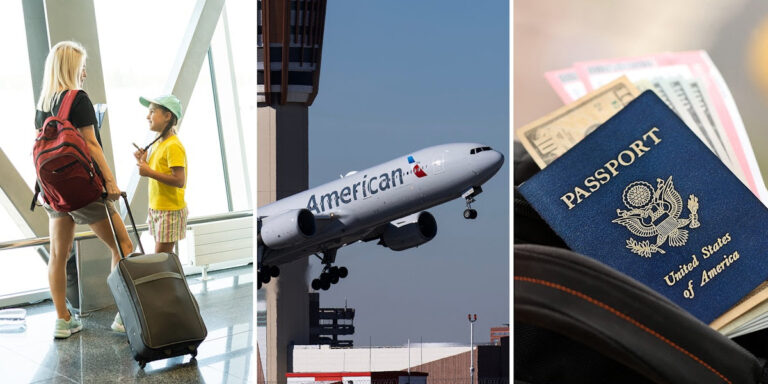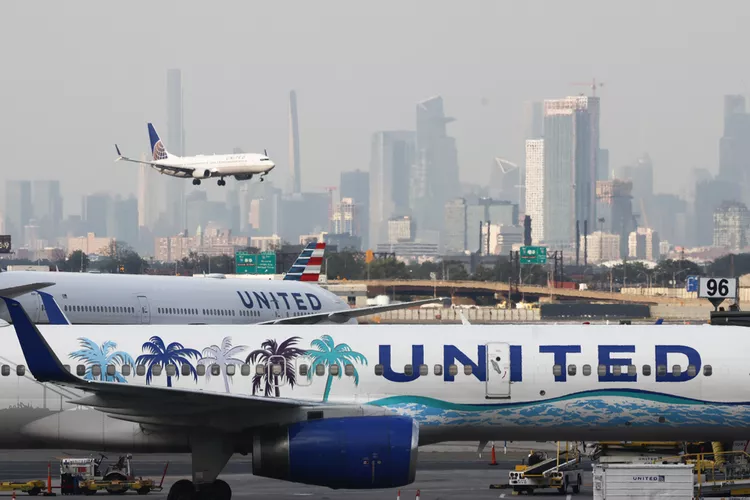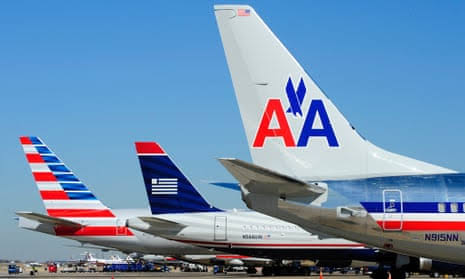United Airlines Cuts Profit Forecast, Blames Domestic Overcapacity
a row of seats with monitors on the side
United Airlines is forecasting lower profit than initially expected this quarter, blaming domestic overcapacity. But the carrier’s annual profit target remains unchanged and it is optimistic that a course correction is in effect as other carriers plan to cut overcapacity in the months ahead, positioning United for more profit.
United Airlines Trims Profit Forecast, Sees Industrywide Correction For Domestic Overcapacity
Like Delta Air Lines announced last week, United’s projected Q2 profit will be lower than expected (between $2.75 to $3.25 per share, rather than the previously forecast $3.44/share). It blames domestic overcapacity for the lower profit, while still positioning itself with Delta in the top-tier of profitability among US carriers.
Despite the lower profitability, United CEO Scott Kirby said all is going according to plan, “At United, we have been effectively managing costs, cash, and capacity against a challenging industry backdrop because we’re focused on doing what’s necessary to hit our financial targets.”
United forecasts that the US airline industry will see an “inflection point” beginning in August during which time capacity will adjust downward (leading to higher prices for consumers in a simple supply-demand model):
For nearly two years, the airline has been anticipating significant domestic capacity reductions recently announced by a variety of U.S. airlines this summer and mid-August is an inflection point, with published schedule changes showing an approximately 3 point decline in industry capacity growth rate.
When this occurs, United cites three “critical revenue diversity advantages” that is says will propel it to further outpace its (non-Delta) rivals in terms of profitability:
Premium revenue
Up 8.5% in Q2 versus same quarter in 2023
Basic economy revenue
Up 38% year-over-year during Q2
Increased market share among “domestic road warriors”
I don’t doubt these figures for a moment. First, we’ve seen a proliferation of basic economy fares across the route network, incentivizing more passengers to book them not just domestically, but internationally as United seeks to compete not only with Spirit and Frontier in the USA, but also carriers like Norse Atlantic across the ocean.Second, I am the perfect example of how United was able to increase premium revenue. Domestic upgrades are virtually non-existent anymore as a Premier 1K member. Indeed, I earn 1K status because I tend to buy front-cabin seats these days rather than what used to drive me to 1K status: upgrades. Even though I’m largely off the status hamster wheel (I’ll fly what makes sense these days), I still fly enough and prefer United to keep the status.
United will host an earnings call later today and we’ll listen to what Kirby and the rest of the C-Suite have to say. But it does merit mentioning that Kyle was right on when he noted many weeks ago what appeared to be an industrywide slowdown from the “heyday” of revenge travel.
United hopes that others will cut back service while it continues to expand: that’s an interesting gamble. While United hopes to gain more market share and drive most cost savings through the synergies of a larger and newer fleet, it may be that Boieng delivery delays continue to be a blessing in disguise in a market that appears, at least for the moment, to be saturated.
United Airlines expects healthy Q2 profits, though lower than originally forecast. But with a course correction coming as the summer travel season draws to a close, United hopes that reduced capacity will drive higher margins for its operations. United has been able to capture both ends of the market with more premium fares and more basic economy fares, pointing out the advantage it it has over budget carriers to offer a wider range of products (not to mention a worldwide route map).
United Airlines Trims Profit Forecast Amid Domestic Overcapacity Challenges
United Airlines has adjusted its profit forecast for the current quarter, citing domestic overcapacity as the primary factor for the reduction. Despite this, the airline maintains its annual profit target and is optimistic about the future, anticipating a course correction as other carriers plan to reduce capacity in the coming months. This strategic adjustment is expected to position United favorably for increased profitability.
Profit Forecast Revision
In a recent announcement, United Airlines revealed that its projected Q2 profit will fall below initial expectations. The revised forecast predicts earnings between $2.75 to $3.25 per share, down from the previously estimated $3.44 per share. This adjustment mirrors a similar move by Delta Air Lines, which also lowered its profit expectations for the same period.
The overcapacity in the domestic market is the primary reason for this revision. Despite the lower-than-expected profitability for the quarter, United Airlines remains confident in its overall strategy and long-term financial targets. United’s CEO, Scott Kirby, emphasized the company’s commitment to managing costs, cash flow, and capacity in a challenging industry environment. He stated, “At United, we have been effectively managing costs, cash, and capacity against a challenging industry backdrop because we’re focused on doing what’s necessary to hit our financial targets.”
Industrywide Inflection Point
United Airlines forecasts that the US airline industry will experience an “inflection point” starting in August. During this period, capacity is expected to adjust downward, leading to higher prices for consumers based on a simple supply-demand model. For nearly two years, United has been anticipating significant domestic capacity reductions, recently announced by various U.S. airlines. Mid-August is identified as a critical point, with published schedule changes indicating an approximate three-point decline in the industry’s capacity growth rate.
Revenue Diversity Advantages
United Airlines believes it has three “critical revenue diversity advantages” that will enable it to outperform its competitors, excluding Delta, in terms of profitability. These advantages are:
- Premium Revenue: United’s premium revenue saw an 8.5% increase in Q2 compared to the same quarter in 2023. This growth
a row of seats with monitors on the side
United Airlines is forecasting lower profit than initially expected this quarter, blaming domestic overcapacity. But the carrier’s annual profit target remains unchanged and it is optimistic that a course correction is in effect as other carriers plan to cut overcapacity in the months ahead, positioning United for more profit.
United Airlines Trims Profit Forecast, Sees Industrywide Correction For Domestic Overcapacity
Like Delta Air Lines announced last week, United’s projected Q2 profit will be lower than expected (between $2.75 to $3.25 per share, rather than the previously forecast $3.44/share). It blames domestic overcapacity for the lower profit, while still positioning itself with Delta in the top-tier of profitability among US carriers.
Despite the lower profitability, United CEO Scott Kirby said all is going according to plan, “At United, we have been effectively managing costs, cash, and capacity against a challenging industry backdrop because we’re focused on doing what’s necessary to hit our financial targets.”
United forecasts that the US airline industry will see an “inflection point” beginning in August during which time capacity will adjust downward (leading to higher prices for consumers in a simple supply-demand model):
For nearly two years, the airline has been anticipating significant domestic capacity reductions recently announced by a variety of U.S. airlines this summer and mid-August is an inflection point, with published schedule changes showing an approximately 3 point decline in industry capacity growth rate.
When this occurs, United cites three “critical revenue diversity advantages” that is says will propel it to further outpace its (non-Delta) rivals in terms of profitability:
Premium revenue
Up 8.5% in Q2 versus same quarter in 2023
Basic economy revenue
Up 38% year-over-year during Q2
Increased market share among “domestic road warriors”
I don’t doubt these figures for a moment. First, we’ve seen a proliferation of basic economy fares across the route network, incentivizing more passengers to book them not just domestically, but internationally as United seeks to compete not only with Spirit and Frontier in the USA, but also carriers like Norse Atlantic across the ocean.Second, I am the perfect example of how United was able to increase premium revenue. Domestic upgrades are virtually non-existent anymore as a Premier 1K member. Indeed, I earn 1K status because I tend to buy front-cabin seats these days rather than what used to drive me to 1K status: upgrades. Even though I’m largely off the status hamster wheel (I’ll fly what makes sense these days), I still fly enough and prefer United to keep the status.
United will host an earnings call later today and we’ll listen to what Kirby and the rest of the C-Suite have to say. But it does merit mentioning that Kyle was right on when he noted many weeks ago what appeared to be an industrywide slowdown from the “heyday” of revenge travel.
United hopes that others will cut back service while it continues to expand: that’s an interesting gamble. While United hopes to gain more market share and drive most cost savings through the synergies of a larger and newer fleet, it may be that Boieng delivery delays continue to be a blessing in disguise in a market that appears, at least for the moment, to be saturated.
United Airlines expects healthy Q2 profits, though lower than originally forecast. But with a course correction coming as the summer travel season draws to a close, United hopes that reduced capacity will drive higher margins for its operations. United has been able to capture both ends of the market with more premium fares and more basic economy fares, pointing out the advantage it it has over budget carriers to offer a wider range of products (not to mention a worldwide route map).
United Airlines Trims Profit Forecast Amid Domestic Overcapacity Challenges
United Airlines has adjusted its profit forecast for the current quarter, citing domestic overcapacity as the primary factor for the reduction. Despite this, the airline maintains its annual profit target and is optimistic about the future, anticipating a course correction as other carriers plan to reduce capacity in the coming months. This strategic adjustment is expected to position United favorably for increased profitability.
Profit Forecast Revision
In a recent announcement, United Airlines revealed that its projected Q2 profit will fall below initial expectations. The revised forecast predicts earnings between $2.75 to $3.25 per share, down from the previously estimated $3.44 per share. This adjustment mirrors a similar move by Delta Air Lines, which also lowered its profit expectations for the same period.
The overcapacity in the domestic market is the primary reason for this revision. Despite the lower-than-expected profitability for the quarter, United Airlines remains confident in its overall strategy and long-term financial targets. United’s CEO, Scott Kirby, emphasized the company’s commitment to managing costs, cash flow, and capacity in a challenging industry environment. He stated, “At United, we have been effectively managing costs, cash, and capacity against a challenging industry backdrop because we’re focused on doing what’s necessary to hit our financial targets.”
Industrywide Inflection Point
United Airlines forecasts that the US airline industry will experience an “inflection point” starting in August. During this period, capacity is expected to adjust downward, leading to higher prices for consumers based on a simple supply-demand model. For nearly two years, United has been anticipating significant domestic capacity reductions, recently announced by various U.S. airlines. Mid-August is identified as a critical point, with published schedule changes indicating an approximate three-point decline in the industry’s capacity growth rate.
Revenue Diversity Advantages
United Airlines believes it has three “critical revenue diversity advantages” that will enable it to outperform its competitors, excluding Delta, in terms of profitability. These advantages are:
- Premium Revenue: United’s premium revenue saw an 8.5% increase in Q2 compared to the same quarter in 2023. This growth






